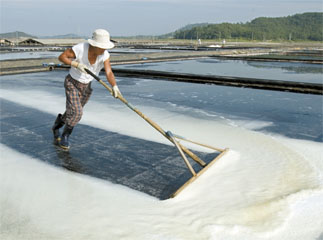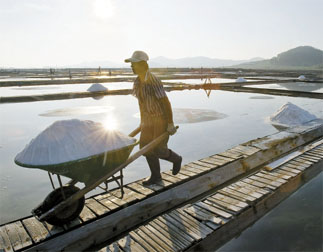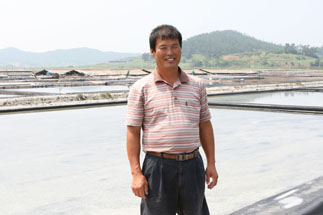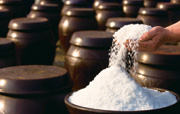Sea salt dried by a scorching sun

Almost like mopping a floor, workers sweep the bottom of the salt fields, which are covered with rubber matting, top, and carry away the small salt piles in barrows, above. At the foreshore of Jeung Island, right, the country’s largest complex for sun dried salt, stands Taepyeong Salt Farm. [JoongAng Ilbo]
“Looks like we are going to have a huge harvest today,” said Park Hyeong-gi, 50, a shift leader at Taepyeong Salt Farm, the country’s largest complex for sun-dried salt.
Park is a second-generation salt farmer and his gut tells him this year will bring a good harvest.
Even with fall around the corner, temperatures on the farm are scorching, but no one is complaining.

On this particular day, the salt workers were drenched in sweat that glistened in the sun as they carted off barrow loads of salt.
They swept the flats, which are covered with rubber matting, where the seawater evaporates, leaving behind the salt.
For the last two years, heavy rain after August dented production.
Not so this year. Since August, rain has been rare and the sun unrelenting. August is the prime month for salt farming. During this period, a typical salt farm expects to produce close to 40 percent of the year’s total production, provided the weather holds up.

Harvesting the salt begins around 4 p.m. in the afternoon. It takes time for the seawater to evaporate and the salt to appear. Work often continues late into the night.
“When the weather is hot during summer, salt forms well into the night,” said Park. “If you work late, you’ll increase your overall yield.”
A nose for the weather, especially for the onset of rain, is a great help in this line of business.
In an age where supercomputers and weather satellites have become soothsayers, Park’s ability to forecast the wind, rain and sun is legendary.
When the weather forecast predicted an 80 percent chance of rain on Aug. 2 this year, other shift leaders at the farm were busy collecting seawater from the fields and putting it into a warehouse.

Park Hyeong-gi
So when everyone else was busy harvesting, Park did the opposite. He ordered his men to continue to hold back, the rain never came and as a result, his team produced an extra 200 gama of salt.
Park has his own methods. “If you look at the western sky at sunset and you can’t see the sun, there is a high chance that there will be rain [the next day]. It’s the same with a wind coming from the east,” he said.
Sometimes he looks at the direction a certain bird flies for clues.
“Just because you can see the stars at night does not guarantee clear weather the next day,” warned Park, who says he also watches the weather channel for general guidelines.
The fact that the average temperature for Jeung Island has increased by two degrees compared to 20 years ago has also helped the farm produce more salt.

The weather can make a significant difference, allowing a farm to produce up to 600 kilograms more a day, if there is more sunshine and no rain.
It’s not only heat that’s needed. Wind is also a factor.
“A light breeze, just enough to gently lift a skirt, is essential,” explains Park.
Just as scientists warn of global warming, Park said the overall climate has changed a lot here.
“After the monsoon season in the past, we used to have hot days. But there are so many random rainy days today even after the monsoon season that the saltwater gets ruined,” said Park, who added that he felt sympathy for the weather professionals.
“The weather forecast is often wrong, but I appreciate the difficulties,” he said.
South Jeolla’s islands are ideally suited to sea salt production. The flats and the wind conditions help this area produce 87 percent of the country’s needs.
Why is sea salt so special?
Food enthusiasts claim normal salt is salty from the first to the last taste, but sun-dried salt is salty first then sweet at the end.
This kind of salt produced at Taepyeong is often used in gourmet restaurants.
While Park has built his reputation on getting the weather right and making the correct calls, he thinks there’s no real secret to producing good sun-dried sea salt.
“You just got to work hard,” said Park.
By Lee Jong-chan JoongAng Ilbo[africanu@joongang.co.kr]










with the Korea JoongAng Daily
To write comments, please log in to one of the accounts.
Standards Board Policy (0/250자)